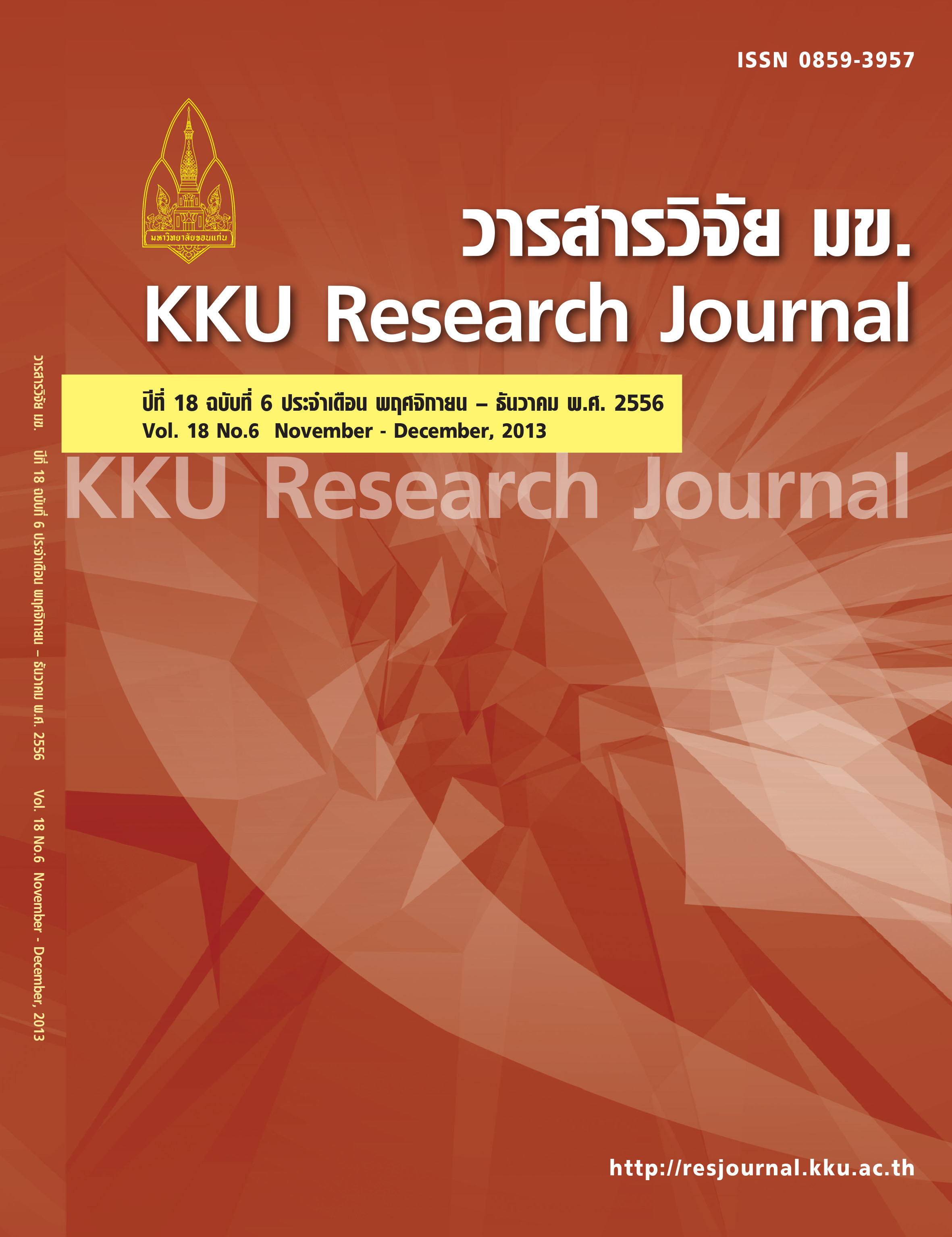Optimal conditions of friction welding process for AISI 1015 steel using response surface methodology
Main Article Content
Abstract
The purpose of this research was to determine the relationship between various important parameters of the friction welding process for AISI 1015 steel to obtain a maximum tensile strength of welding joints. In this study, response surface methodology (RSM) was employed to evaluate the effects of friction time, upset time, friction pressure, upset pressure and rotational speed on the tensile strength of welding joints. The results from the RSM analysis indicate that the friction time, friction pressure and upset pressure have the most significant effect on tensile strength of welding joints, while the upset time and rotational speed were not significant. The coefficient of determination (R2) of the mathematical model was 0.8064. The optimal conditions of friction welding, which obtained the maximum tensile strength of welding joints of 1048 MPa, were performed at friction time of 8.86 sec, upset time of 2.22 sec, friction pressure of 29.36 bar, upset pressure of 59.25 bar and rotational speed of 1259.58 rpm. The experimental values of the optimized condition exhibited tensile strength of welding joints of 1007 MPa. Comparison of the experimental values with those of the predicted values was almost identical with low percentage bias of tensile strength of welding joints of 3.91%. Therefore, the mathematical model has developed adequately describing ranges of the experimental parameters studied and provides a statistically accurate prediction of the optimum tensile strength of welding joints.
Article Details
References
(2) Meshram SD, Mohandas T, Reddy GM. Friction welding of dissimilar pure metals. J Mater Process Tech. 2007;184(1-3):330-7.
(3) Sahin M. Evalution of the joint - interface properties of austenitic - stainless steels (AISI304) joined by friction welding. Mater Design. 2007;28: 2244-50.
(4) Jayabharath K, Ashfaq M, Venugopal P, Achar DRG. Investigations on the continuous drive friction welding of sintered powder metallurgical (P/M) steel and wrought copper parts. Mater Sci Eng: A. 2007;454-455(0):114-23.
(5) Ates H, Turker M, Kurt A. Effect of friction pressure on the friction-welded MA956 iron-based superalloy. Mater Design. 2007;28:948-53.
(6) Li WY, Ma TJ, Yang SQ, Xu QZ, Zhang Y, Li JL, et al. Effect of friction time on fl ash shape and axial shortening of linear friction welded 45 steel. Mater Lett. 2008;62(2):293-6.
(7) Hascalik A, Orhan N. Effect of particle size on the friction welding of Al2O3 reinforced 6160 Al alloy composite and SAE 1020 steel. Mater Design. 2007;28(1):313-7.
(8) Noh MZ, Hussain LB, Ahmad ZA. Alumina - mild steel friction welded at lower rotational speed. J Mater Process Tech. 2008;204:279-83.
(9) Uwaba T, Ukai S, Nakai T, Fujiwara M. Properties of friction welds between 9Cr-ODS martensitic and ferritic-martensitic steels. J Nucl Mater. 2007;367-370, Part B(0):1213-7.
(10) Shin H-S, Jeong Y-J, Choi H-Y, Kato H, Inoue A. Joining of Zr-based bulk metallic glasses using the friction welding method. J Alloy Compd. 2007;434-435(0):102-5.
(11) Chutima P. Experimental design of engineering: Chulalongkorn University Press; 2002. Thai.
(12) Chanphong S, Tangjitsitcharoen S. Surface rouqhness prediction in turning process by utilizing response surface method. Proceedings of the Industial Enginering Network Conference; 2011 Oct 20-21. Thai.
(13) Chooppava C, Thinvongpituk C. The infl uence of friction time and rotational speed on the strength of AISI 1015 steel rods welded by friction welding. J Sci Technol UBU. 2011;13(1):73-81. Thai.
(14) Chooppava C, Thinvongpituk C. Infl uence of friction time on the strength of AISI 1015 steel rods welded by friction welding. UBU En J. 2010;3(2):17-24. Thai.
(15) Saikaew C, Chillapat N. Experimental design for product and process improvement: an application in bottle glass crushing machine. KKU En J. 2006;33(4):415-30. Thai.


